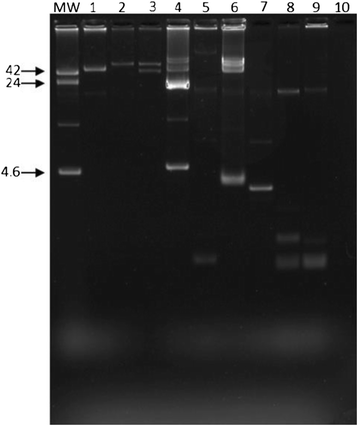High prevalence of diarrheagenic Escherichia coli carrying toxin-encoding genes isolated from children and adults in southeastern Brazil
- PMID: 29254489
- PMCID: PMC5735577
- DOI: 10.1186/s12879-017-2872-0
High prevalence of diarrheagenic Escherichia coli carrying toxin-encoding genes isolated from children and adults in southeastern Brazil
Abstract
Background: Diarrheagenic Escherichia coli (DEC) are important bacterial causes of childhood diarrhea in Brazil, but its impact in adults is unknown. This study aimed at investigating DEC among children and adults living in endemic areas.
Methods: A total of 327 stools specimens were collected from children (n = 141) and adults (n = 186) with diarrhea attending health centers. Diarrheagenic E. coli (DEC) were identified by their virulence genes (multiplex polymerase chain reaction) and HEp-2 cell adherence patterns.
Results: DEC were detected in 56 (40%) children and 74 (39%) adults; enteroaggregative E. coli (EAEC) (23%) was the most prevalent pathotype, followed by diffusely adherent E. coli (DAEC) (13%), and occurred at similar frequencies in both diarrheal groups. Atypical enteropathogenic E. coli (aEPEC) strains were recovered more frequently from children (6%) than from adults (1%). Twenty-six percent of the EAEC were classified as typical EAEC possessing aggR gene, and carried the aap gene. EAEC strains carrying aggR-aap-aatA genes were significantly more frequent among children than adults (p < 0.05). DAEC strains possessing Afa/Dr. genes were detected from children (10%) and adults (6%). EAEC and DAEC strains harboring genes for the EAST1 (astA), Pet, Pic, and Sat toxins were common in both diarrheal groups. The astA and the porcine AE/associated adhesin (paa) genes were found in most of aEPEC strains. High levels of resistance to antimicrobial drugs were found among DAEC and aEPEC isolates.
Conclusion: The results show a high proportion of EAEC and DAEC carrying toxin-encoding genes among adults with diarrhea.
Keywords: Adults; Children; Diarrheagenic E. coli.
Conflict of interest statement
Ethics approval and consent to participate
The study was approved by the Ethical Committee of the Universidade Federal do Espírito Santo, Brazil. Stool samples were obtained with the written informed consent from the adults and from the parents or guardians of the children.
Consent to publication
Not applicable.
Competing interests
The authors declare that they have no competing interests.
Publisher’s Note
Springer Nature remains neutral with regard to jurisdictional claims in published maps and institutional affiliations.
Figures


Similar articles
-
Genetic Virulence Profile of Enteroaggregative Escherichia coli Strains Isolated from Danish Children with Either Acute or Persistent Diarrhea.Front Cell Infect Microbiol. 2017 May 30;7:230. doi: 10.3389/fcimb.2017.00230. eCollection 2017. Front Cell Infect Microbiol. 2017. PMID: 28611957 Free PMC article.
-
Diarrheagenic Escherichia coli pathotypes investigation revealed atypical enteropathogenic E. coli as putative emerging diarrheal agents in children living in Botucatu, São Paulo State, Brazil.APMIS. 2016 Apr;124(4):299-308. doi: 10.1111/apm.12501. Epub 2016 Jan 11. APMIS. 2016. PMID: 26752102
-
Genotypic and phenotypic analysis of diarrheagenic Escherichia coli strains isolated from Brazilian children living in low socioeconomic level communities.BMC Infect Dis. 2013 Sep 8;13:418. doi: 10.1186/1471-2334-13-418. BMC Infect Dis. 2013. PMID: 24010735 Free PMC article.
-
[Virulence mechanisms of enteropathogenic Escherichia coli].Rev Chilena Infectol. 2016 Aug;33(4):438-450. doi: 10.4067/S0716-10182016000400009. Rev Chilena Infectol. 2016. PMID: 27905628 Review. Spanish.
-
Diarrheagenic Escherichia coli in sub-Saharan Africa: status, uncertainties and necessities.J Infect Dev Ctries. 2009 Nov 27;3(11):817-42. doi: 10.3855/jidc.586. J Infect Dev Ctries. 2009. PMID: 20061678 Review.
Cited by
-
Antibiotic resistance, pathotypes, and pathogen-host interactions in Escherichia coli from hospital wastewater in Bulawayo, Zimbabwe.PLoS One. 2023 Mar 2;18(3):e0282273. doi: 10.1371/journal.pone.0282273. eCollection 2023. PLoS One. 2023. PMID: 36862713 Free PMC article.
-
Antimicrobial Profiles and Conventional PCR Assay of Shiga Toxigenic Escherichia coli O157:H7 (STEC) Isolated from Cattle Slaughtered at Bedele Municipal Abattoir, South West Ethiopia.Infect Drug Resist. 2023 Jan 25;16:521-530. doi: 10.2147/IDR.S388102. eCollection 2023. Infect Drug Resist. 2023. PMID: 36721631 Free PMC article.
-
Characterization and antibiotic resistance pattern of diffusely adherent Escherichia coli (DAEC), isolated from paediatric diarrhoea in Shiraz, southern Iran.New Microbes New Infect. 2020 Oct 10;38:100780. doi: 10.1016/j.nmni.2020.100780. eCollection 2020 Nov. New Microbes New Infect. 2020. PMID: 33163200 Free PMC article.
-
Diarrheagenic Escherichia coli in Stool Specimens Collected from Patients Attending Primary Healthcare Facilities in Ethiopia: Whole-Genome Sequencing-Based Molecular Characterization.Int J Mol Sci. 2024 Sep 24;25(19):10251. doi: 10.3390/ijms251910251. Int J Mol Sci. 2024. PMID: 39408580 Free PMC article.
-
Typical and Atypical Enteroaggregative Escherichia coli Are Both Virulent in the Galleria mellonella Model.Front Microbiol. 2019 Aug 13;10:1791. doi: 10.3389/fmicb.2019.01791. eCollection 2019. Front Microbiol. 2019. PMID: 31456762 Free PMC article.
References
-
- Kotloff KL, Nataro JP, Blackwelder WC, et al. Burden and aetiology of diarrhoeal disease in infants and young children in developing countries (the global enteric multicenter study, GEMS): a prospective, case-control study. Lancet. 2013;382:209–222. doi: 10.1016/S0140-6736(13)60844-2. - DOI - PubMed
-
- WHO. Diarrhoea. Available at: http://www.who.int/topics/diarrhoea/en/. Accessed 13 April 2017.
MeSH terms
Substances
Grants and funding
LinkOut - more resources
Full Text Sources
Other Literature Sources
Medical
Research Materials
Miscellaneous

